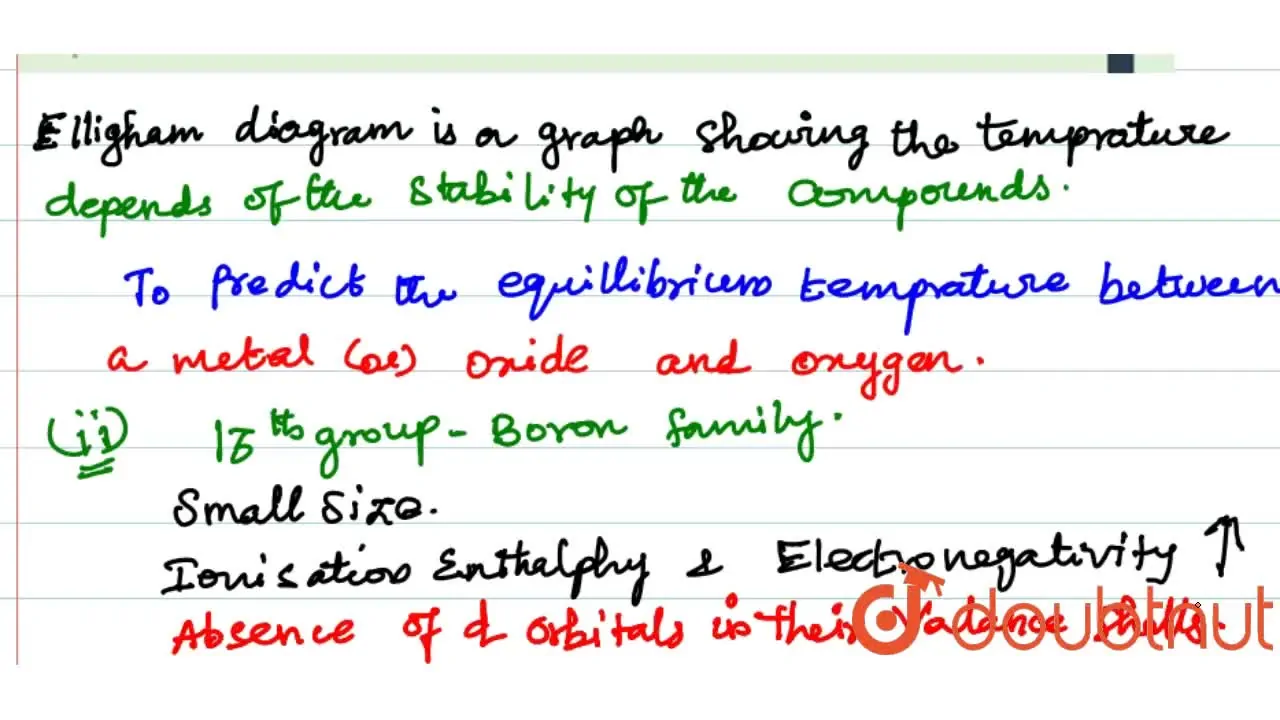(i) Explain the observations from the Ellingham diagram.
(ii) Write a short note on anamolous properties of the first element of p-block. Solution in Tamil
(i) 1. For most of the metal oxide formation, the slope is positive. It can be explained as follows. Oxygen gas is consumed during the formation of metal oxides which results in the decrease in randomness. Hence, ΔS becomes negative and it makes the term, TΔS positive in the straight line equation.
2. The graph for the formation of carbon monoxide is a straight line with negative slope. In this case ΔS is positive as 2 moles of CO gas is formed by the consumption of one mole of oxygen gas. It indicates that CO is more stable at higher temperature.
3. As the temperature increases, generally ΔG value for the formation of the metal oxide become less negative and becomes zero at a particular temmperature. Below this temperature, ΔG is negative and the oxide is stable and above this temperature ΔG is positive. This general trend suggests that metal oxides become less stable at higher temperature and their decomposition becomes easier.
4. There is a sudden change in the slope at a particular temperature for some metal oxides like MgO, HgO. This is due to the phase transition (melting or evaporation).
(ii) In p-block elements the first member of each group differs from the other elements of the corresponding group. The following factors are responsible for this anomalous behaviour.
Small size of the first member.
High ionisation enthalpy and high electronegativity.
Absence of d-orbitals in their valance shell.
The first member of the group-13, boron is a metalloid while others are reactive metals. Moreover, boron shows diagonal relationship with silicon of group 14. The oxides of boron and silicon are similar in their acidic nature.
Related Playlists
- BOOK - FULL MARKSCHAPTER - SAMPLE PAPER - 3 EXERCISE - PART-III (Answer the questions)9videos
SAMPLE PAPER - 3
- BOOK - FULL MARKSCHAPTER - SAMPLE PAPER - 20 (UNSOLVED)EXERCISE - PART - IV1videos
SAMPLE PAPER - 20 (UNSOLVED)
- BOOK - FULL MARKSCHAPTER - SAMPLE PAPER - 5 (SOLVED)EXERCISE - PART - III14videos
SAMPLE PAPER - 5 (SOLVED)
Similar Questions
Write a note on zeolites.
03:21View Solution(b) (i) Identify the Lewis acid and the Lewis base in the following reactions.
Cr3++6H2O→[Cr(H2O)6]3+
(ii) Define buffer capacity and buffer index.04:32View SolutionExplain the action of heat on boric acid .
03:21View Solutionनिम्नलिखित पर संक्षिप्त टिप्पणी लिखें -
(i) d -ब्लॉक के तत्त्वों का उत्प्रेरकी गुण।
(ii) एक्टिनॉइड्स का आवर्त सारणी में स्थान ।View Solutionp-ब्लॉक के तत्वों के गुण लिखिए । (चार)
View SolutionWrite the short note on anamolous properties of the first element of p - block.
View SolutionWrite a note on metallic nature of p-block elements.
View Solution(a) (i) What is Cementation?
(ii) Write a notes on ionisation enthalpy in p-block elements?03:21View SolutionWrite a note on metallic nature of p-block elements.
View SolutionExplain the observations from the Ellingham diagram.
View SolutionWrite the short note on anamolous properties of the first element of p - block.
04:29View SolutionWrite a note on metallic nature of p-block elements.
04:45View SolutionWrite a notes on ionisation enthalpy in p-block elements?
03:27View SolutionWrite a brief note on - (i) General electronic configuration of the elements of the p block (ii) Interhalogen compounds.
View SolutionWrite a short note on (i) Embryogenesis, (ii) Syngamy
View Solution


